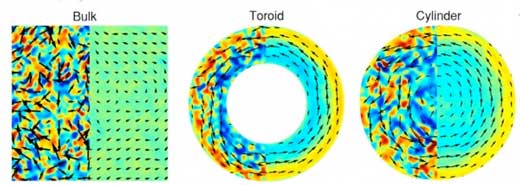| Posted: Oct 03, 2017 |
Blurring the line between animate and inanimate: 'Active' matter drives self-propelled fluid
(Nanowerk News) With huge potential energy savings for technologies ranging from sensors to supercomputers, this new mechanism created self-propelling fluid with energy-harvesting machines. These machines were composed of filaments and molecular motors.
|
|
For the first time, fluid with directionless flow autonomously flowed unidirectionally through meter-long 3-D channels until the chemical energy was depleted. The direction of the flow could be controlled with notches in the pipe. Its strength and speed could be regulated by the structure of the machines, referred to as “soft” because their operation is driven by structural alterations arising from changes in temperature or forces such as mechanical stress.
|
 |
| Upon confinement and powered by tiny molecular motors, an “active” fluid transitions from locally chaotic (left) to long-range unidirectional flow, as seen in the donut-shaped (center) and circular (right) pipes. Each figure contains the instantaneous (left) and time-averaged (right) motion. Localized counter-clockwise (blue) and clockwise (red) whirlpools are shown. The organization of the colored areas is a measure of the extent to which the fluid is flowing in one direction. (Image: Zvonimir Dogic, Brandeis University)
|
|
This new mechanism to harvest energy and propel fluids has no known upper limit. It harnesses the local movement of nanometer-sized machines to drive the transition from a chaotic fluid to one that flows persistently in one direction over long distances.
|
|
Self-propelled fluids could save energy for a range of technologies that depend on controlled fluid transport. These technologies include tiny sensors, diagnostic devices, microfluidic fuel cells for phones and cooling methods for supercomputers.
|
|
Many technologies require expensive external energy to move fluids. In contrast, cells and other microscopic biological materials move fluids using far less energy. This motion comes from stored energy accessed by molecular motors constructed from proteins. Mimicking such materials that derive energy solely from the local environment to perform work (“active” matter) remains a fundamental science challenge.
|
|
Previously, this self-propulsion of fluids was only achieved over small distances, millimeters or centimeters. Now scientists at Brandeis University demonstrated that a fluid composed of protein microtubules and molecular motors autonomously flows through 3-D channels ranging in size from microns to meters (Science, "Transition from turbulent to coherent flows in confined three-dimensional active fluids").
|
|
For these active fluids confined in 3-D donut-like and cylindrical pipes, a transition from chaotic, directionless to coherent, unidirectional flows occurs abruptly when the width and height of the channel are within a factor of 3 of each other (i.e., an aspect ratio of 1 to 3).
|
|
The critical feature that induces this transition is a rearrangement of active motors and filament bundles near the channel surface. In general, the protein motors move linearly along the filaments. This extending, buckling, fracturing and reforming create stress and whirlpools in its immediate vicinity. At the point where the aspect ratio reaches 1:3, the bundle orientation becomes trapped. The resulting stresses induce more unidirectional flows.
|
|
In turn, the layers of fluid passing over each other stabilize the flow and amplify bundle orientation across the pipe surface. This positive feedback loop yields the transition to globally coherent currents able to transport material over longer distances.
|
|
This transition is a robust feature of confined active fluids and is an intrinsic 3-D phenomenon depending solely on the aspect ratio of the confining geometry. By applying concepts from biology for managing fluid transport, it is now possible to assemble self-organized machines fueled by the collective motion of constituent nanometer-sized motors that produce useful work by powering large-scale fluid flow.
|

